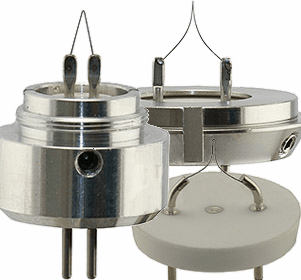
Introduction

The tungsten filaments manufactured by Energy Beam Sciences are used in all major brands of scanning and transmission electron microscopes. These high quality, high stability tungsten EM filaments, also called cathodes or electron emitters, are manufactured to excede the specifications of the original equipment manufacturers. These superior cathodes are made using high quality ceramic dics, exact size contact pins and high grade tungsten filament wire. Special tools are used to produce the correct shape of the tungsten filament. All EBSciences tungsten filaments are precisely aligned and annealed in high vacuum to reduce stress in the filament. This will guarantee optimum stability, maximum brightness, longer lifetime and overall lower running costs.
Exclusive features of the EBS tungsten EM filaments are:
- Minimum tip radius for coherent beam
- Rigid attachment of filament wire to post to increase stability
- Fully stress relieved for enhanced cathode lifetime
- Polished post ends
- Precise dimensions
- Better long term economy
Please consult the following table for the correct type of tungsten filament for your SEM, TEM or Microprobe. The EBS tungsten filaments are available for FEI, Hitachi, ISI, JEOL, Philips, Tescan, Zeiss, LEO, Cambridge Instruments, Leica, AmRay, Pemtron and CamScan Electron Microscopes.
Tungsten Filament Selection Table
| Electron Microscope Type or Filament base | Product number | Ceramic Disc mm | Pin Diameter mm | Pin Pitch mm |
| AEI | 14-AE1201 | 12.0 | 1.0 | 6.45 |
| AmRay /AMR (except 1200 series) | 14-AM1202 | 26.0 | 1.0 | 5.0 |
| Cambridge Instruments (except S4-10) | 14-AE1201 | 12.0 | 1.0 | 6.45 |
| CamScan with AEI conversion | 14-AE1201 | 12.0 | 1.0 | 6.45 |
| CamScan with new Tescan Column | 14-TN1209 | 19.8 | 1.0 | 5.0 |
| FEI | 14-FP1203 | 26.0 | 1.0 | 5.0 |
| Hitachi S-Type |
14-HI1204 |
9.8 | 1.2 | 2.7 |
| Hitachi with Cartridge TM series tabletop 3400N, 3700N, SU1500, SU3500 |
14-HT1205 | 9.8 | 1.2 | 2.7 |
| ISI /ABT / Topcon 2-Pin | 14-I21206 | 23.4 | 1.2 | 12.0 |
| JEOL K-Type with metal ring | 14-JL1208 | 28.0 | 1.2 | 8.0 |
| Leica | 14-AE1201 | 12.0 | 1.0 | 6.45 |
| LEO 400 and 1400 Series SEM | 14-AE1201 | 12.0 | 1.0 | 6.45 |
| LEO1450 (except AEI conversions) | 14-ZS1210 | 19.8 | 1.0 | 5.0 |
| LEO TEM | 14-ZS1210 | 19.8 | 1.0 | 5.0 |
| Pemtron | 14-PT1211 | 23.4 | 1.2 | 12.0 |
| Philips V-Loop (PSEM500/EM200 and later) | 14-FP1203 | 26.0 | 1.0 | 5.0 |
| Tescan | 14-TN1209 | 19.8 | 1.0 | 5.0 |
| Zeiss DSM and TEM | 14-ZS1210 | 19.8 | 1.0 | 5.0 |
| Zeiss EVO | 14-AE1201 | 12.0 | 1.0 | 6.45 |
Electron Source Performance Table
The electron source performance table is provided to give additional information regarding the performance and requirements for different type of electron emitters. Tungsten cathodes are still used in the majority in SEMs and in general use TEMs. Improved results can be obtained with LaB6 cathodes, whereas the highest resolution can be obtained with either Schottky or cold Field Emission Sources which can only be used in suitable EMs.
| Emitter Type | Thermionic | Thermionic | Schottky FE | Cold FE |
| Cathode Material | W | LaB6 | ZrO/W (100) | W (310) |
| Operating Temp (K) | 2700 | 1800 | 1800 | 300 |
| Cathode Radius (nm) | 60,000 | 10,000 | <1000 | <100 |
| Effective Source Radius (µm) | 25 | 10 | 0.015 | 0.0025 |
| Emission Current Density (A/cm2) | 3 | 30 | 5300 | 17,000 |
| Total Emission Current (µA) | 200 | 80 | 200 | 5 |
| Brightness (A/cm2.sr.kV) | 1x104 | 1x105 | 1x107 | 2x107 |
| Maximum Probe Current (nA) | 1000 | 1000 | 10 | 0.2 |
| Energy Spread @ Cathode (ev) | 0.59 | 0.4 | 0.31 | 0.26 |
| Energy Spread @ Source Exit (eV) | 1.5 – 2.5 | 1.3 – 2.5 | 0.35 – 0.7 | 0.3 – 0.7 |
| Beam Noise (%) | 1 | 1 | 1 | 5 – 10 |
| Emission Current Drift (%/h) | 0.1 | 0.2 | <0.5 | 5 |
| Operating Vacuum (hPa/mbar) | <10-5 | <10-6 | <10-8 | <10-10 |
| Typical Cathode Life (h) | 100 | >1000 | >5000 | >2000 |
| Cathode Regeneration (h) | None | None | None | 6-12 |
| Sensitivity to External Influences | Minimal | Low | Low | High |
